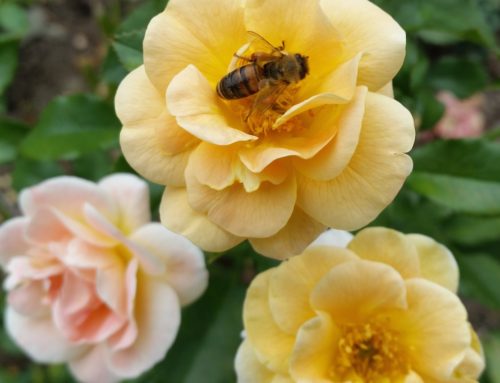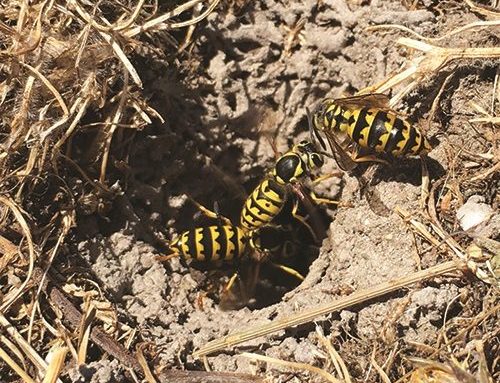Being a dairy owner in a previous life (kinda went hand in hand with my veterinary practice), I have now been through both the worlds of milk and honey!! lol!! The honest truth is – I like the land of honey better. There was the twice a day milking of the dairy animals at 4:00 am and 4:00 pm, not to mention the feeding at 5 and 5, then babies needed bottle feeding from January through May until they were weaned and put through the sale barn or transferred to solid food. When you add up the three times a day feedings for all the bottle babies, milking, feeding the dairy girls, birthing babies and prepping the moms for the line, and then maintenance on fences, equipment, cleaning, bottling, deliveries, USDA inspections, and then the business part of a business…..well, there just aren’t enough hours in the day. My spousal unit will tell you, I function on a schedule that most would consider unreasonable slavery, but once you’ve been through the worst that agriculture demands like a dairy, a 14 hour day seems pretty tame!!
So, let’s talk about honey – my favorite sweet food – maybe, with ice wine coming in a close second!! lol…. I love to see the girls putting nectar into comb, and then drying it until they think it’s perfect for capping – the beauty of a capped frame of honey is indescribable!! It’s a product that no other animal in the world can make and does so with such artistic flair. The perfectly capped frame of honey is a thing of beauty!!
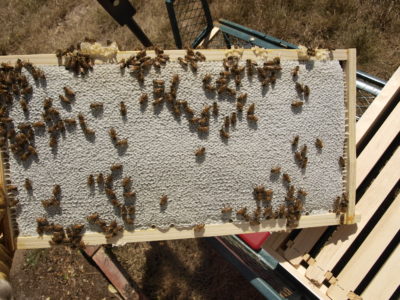
Harvest for Beekeepers
So if they make excess, can we take what they don’t need?? Much like dairy animals, we produce and manage farm animals for excess. So that they can make much more than they ever need to use for the baby animals they’re supposed to feed with it. Then, we created a system where the babies don’t need the milk that is produced at all if we give them a milk replacer, so for milk, it’s all ours to take – we’ve gotten used to this system, but does it work for honey bees? Well, no….
There are a lot of complicated dynamics involved in the nutritional requirements of animals (I had to study nutrition for two years in medical school and one year undergrad, so here’s what I know for sure). It’s well beyond the scope of this short blog to get it fully explained and understanding protein and carbohydrate requirements of a species is very complex. Add to that, the fact that we haven’t even scraped the surface of nutritional research in the honey bee to any great extent. So what do we know? We know they need 10 essential amino acids (protein building blocks), and they require sucrose (which they either break down into glucose and fructose, or they use the components directly). Add to that are a basket full of fatty acids, and micro/macro elements they require as well (…and we honestly don’t know much about those). Needless to say, they work hard to get what they need out of the components given to them by the plants via flowers. So, we know that nectar is produced by the plant and harvested by the honey bee, but did you know that the nectar isn’t the end of the story?
First there’s the plant part – is the bee getting all it needs and more from the flowers it’s visiting? Not this year – our rainfall deficit here is currently at about 3″ (no significant rainfall in June, July or August so far). When the plant is moisture deficient, there’s no spare moisture to put into the flowers – no nectar, no honey! No honey, no money for the beekeeper. Very simple.
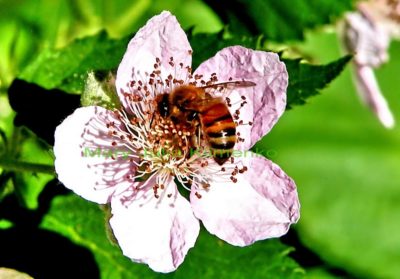
High value nectar source – wild blackberry
If there is excess nectar – there’s still a lot of work to do to get it to be honey. It requires a lot of dehydration to get it down to about 18% water content. Why 18% you ask?? Because at 18%, the honey doesn’t ferment causing it to spoil in the comb – it is a product that is “shelf stable” for pretty much forever!! To get a 50% water content material down to 18% requires a lot of drying (that’s a lot of wing flaps my friend!!). Once capped it’s good to go for as long as the bees need to store it. ….but, how much is enough? That’s the fine line every beekeeper walks each winter – how much can I take without them starving to death in the middle of February? The answer isn’t simple, as a matter of fact it’s very complex. It’s about averages. The average colony, experiencing the average winter, with the average disease challenges can make it through until end of March with about 70-80# of honey here in western Washington (very mild winters). What if the winter isn’t average, or the colony is a little larger than average, or the mite load going into winter bee rearing was a little higher than normal? Then you don’t make it – it’s why 45-50% of colonies die before they make it to spring. If the queen doesn’t start laying replacement bees in February it’s because she doesn’t think there’s enough bees to rear them in the colony. Why aren’t there enough bees? ….because too many of them died prematurely, or the honey stores weren’t sufficient to feed the critical mass of bees required to keep the colony heated and too many died. It takes 3 weeks for a bee egg to hatch into an adult bee. If she delays laying for 3-4 weeks, and the winter bees die a little early, maybe 3-4 weeks before they should in April due to starvation or disease – the gap even if it’s one day is death for the colony. If the baby bees aren’t covered in adults to keep them warm in the cells they chill and die within hours. The more bees die, the more baby bees die around the periphery of the cluster. It’s literally a death spiral.

Emergency feeding in spring – Sugar on top of a colony
So when you look at a jar of honey on the shelf, there’s a reason it’s there, the world was in balance for that season. What does that mean?? lol Well the weather was adequate, the plants provided enough nectar to feed the bees what they needed, the bees had sufficient population to get nectar in quantity to provide excess, and the beekeeper did their job well controlling disease and nutrition for their charges…..therefore the bees didn’t need what’s in that jar. The beekeeper made that call though not the bees!! Sometimes we get it right and sometimes we don’t. The cost is that bees die, and the beekeeper has to pay to replace that colony in the spring. …or spend time out in the cold providing emergency feed for a colony that came up short.
So now that you know some of what goes into honey, please savor every drop of it – it is precious, both to the bees and the beekeeper!! Enjoy!!
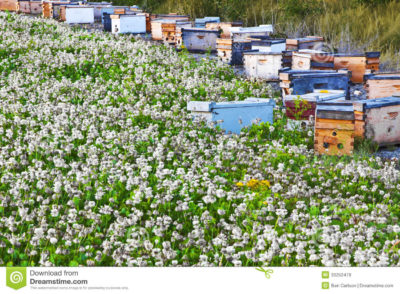
Bees in clover



